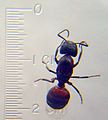| Revision as of 23:09, 31 January 2006 editGdrbot (talk | contribs)45,158 editsm nomialbot — converted multi-template taxobox to {{Taxobox}}← Previous edit | Revision as of 06:18, 2 February 2006 edit undoShyamal (talk | contribs)Autopatrolled, Administrators98,652 edits →SpeciesNext edit → | ||
| Line 25: | Line 25: | ||
| * ''Camponotus pennsylvanicus'' (DeGeer), Black Carpenter Ant | * ''Camponotus pennsylvanicus'' (DeGeer), Black Carpenter Ant | ||
| * ''Camponotus variegatus'' | * ''Camponotus variegatus'' | ||
| * '']'' | |||
| <gallery> | <gallery> | ||
Revision as of 06:18, 2 February 2006
| Carpenter ant | |
|---|---|

| |
| Scientific classification | |
| Kingdom: | Animalia |
| Phylum: | Arthropoda |
| Class: | Insecta |
| Order: | Hymenoptera |
| Family: | Formicidae |
| Genus: | Camponotus |
| Species | |
|
See text. | |
Carpenter ants are large, black ants (1/4" - 1") indigenous to large parts of the world. They prefer dead, damp wood in which to build nests. It is believed the species of poison arrow frogs that are toxic become so through their diet, which consists in part of carpenter ants.
Species
- Camponotus atriceps
- Camponotus chromaiodes
- Camponotus ferrugineus (Fab.), Red Carpenter Ant
- Camponotus nearcticus (Emery), Smaller Carpenter Ant
- Camponotus pennsylvanicus (DeGeer), Black Carpenter Ant
- Camponotus variegatus
- Camponotus sericeus
External links
- University of Kentucky Extension Fact Sheet (Mike Potter)
- Ohio State University Extension Fact Sheet (William F. Lyon)
This insect-related article is a stub. You can help Misplaced Pages by expanding it. |


